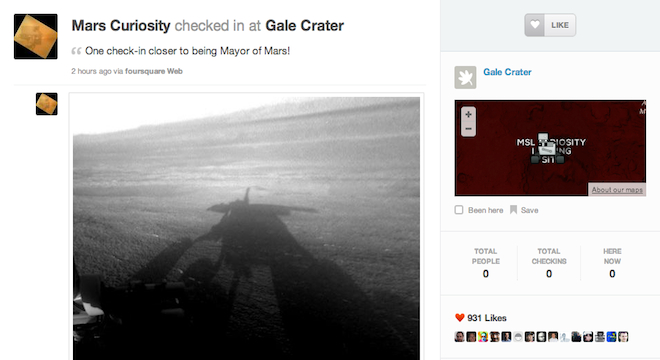Social networking, the final frontier. At least that seems to be the case for NASA’s Mars Curiosity Rover, which on Wednesday made the unexpected move of signing-up for the popular geolocation social network Foursquare and using it to “check in” on the Red Planet.
“One check-in closer to being Mayor of Mars!” the Curiosity rover wrote in its caption for the check-in, also posting the message to its followers on Twitter.
The rover’s mention of “Mayor” refers to Foursquare’s in-network practice of awarding users that title when they obtain the most days of check-ins for a particular spot within the past 60 days. Recipients of the award need to have at least two check-ins to receive it, so Curiosity needs just one more to become the “Mayor” of the fourth planet from the Sun.
Curiosity also included in its check-in a black and white image of the surface of Mars and its own shadow stretching across the barren landscape, as seen by the rover’s cameras on its fiftieth Martian day (or “Sol”).
See that image here below, via NASA and Foursquare:

Foursquare founder and CEO Dennis Crowley was clearly thrilled with his product’s latest user, tweeting on Wednesday shortly after the rover’s check-in: “Um, awesome!”
Foursquare, which counts 25 million users here on Earth, launched in March 2009 allowing smartphone users to announce their precise location — such as restaurants and concert venues — to their followers by referencing GPS data taken from their smartphones.
But the Mars Curiosity Rover — despite having its own operating system and apps — doesn’t have any smartphone sensors on it, let alone GPS (global positioning system, an entirely Earth-based satellite system).
Instead, Curiosity’s science and engineering teams obtained the coordinates of the rover on the Red Planet using its own onboard sensors and the NASA satellites currently orbiting Mars, then sent them to NASA’s social media team who sent them off to Foursquare’s staff, who uploaded the coordinates into the Foursquare website and created an account for the Curiosity rover.
“We worked closely with Foursquare on this, it was a joint initiative,” said Courtney O’Connor, a social media specialist at NASA’s Jet Propulsion Laboratory, which is in charge of the rover’s operations.
The resulting check-in, sent from “Gale Crater,” the 96-mile-wide ancient impact site where Curiosity landed and is currently roaming, makes history as the first interplanetary use of Foursquare.
The check-in now appears on a digital map of Mars on Foursquare, colored red and styled in the same format as the Foursquare maps of Earth, which were created by D.C. startup company Mapbox using data from the OpenStreetMap project, a crowdsourced mapping initiative created by over 800,000 volunteer cartographers around the globe.
It should be noted, though, that Curiosity’s check-in is not the first by someone or something off the Earth’s surface: That actually happened almost exactly two years ago, back in October 2010, when NASA astronaut Douglas H. Wheelock used the service to check-in from the International Space Station, of which he was then in command.
Still, this particular Martian check-in is notable outside of the novelty of taking place on the Red Planet because it marks the beginning of a stronger collaboration between NASA and Foursquare, as well as NASA’s own increasing use of diverse social media platforms to promote awareness of its missions and communicate with citizens.
Specifically, NASA plans to continue updating the Curiosity rover’s Foursquare account with new check-ins as the rover drives around the Martian landscape and performs science experiments at different locations. NASA has invited users to follow along on the account, which, aside from the rover’s initial check-in, also contains several “tips,” another piece of Foursquare content commonly shared by users here on Earth, which are basic guidelines about specific restaurants, venues, stores and other locations.
“Mars is cold, dry and rocky,” reads one of Curiosity’s tips for visiting Mars, “Extra moisturizer and sturdy shoes would be a good idea, plus oxygen for those of you who breathe.”
Aside from Foursquare, the rover’s social media team’s wit has turned its Twitter and Facebook accounts into viral sensations, but NASA social media specialist O’Connor told TPM that these efforts are just the beginning of NASA’s social media strategy for the rover.
“A great way to keep public engaged is by bringing in new social media platforms,” O’Connor said. “This is not the end of that. The rover is on a two-year prime mission. We don’t even know what [social networks] people will be using in two years. It’s exciting to think about the different platforms people will be joining.”
But asked about social networks of now, and whether the Curiosity team would ever create an account on Instagram or Pinterest for the rover, O’Connor declined to provide any concrete plans.
“We’re exploring all these options,” O’Connor told TPM. “We’d love the idea of a Mars filter on Instagram, though.”






